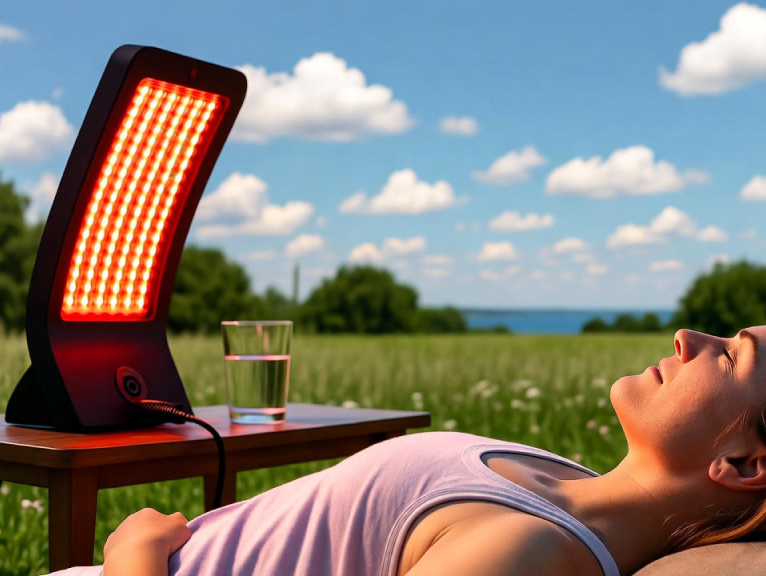
20 Years of Producing the Highest Quality, Most Reliable, and Effective LED mask.
Discover why vitamin D is scarce in vegetarian diets and how red light therapy supports its production to combat deficiency. Explore the science, benefits, research, applications, and practical tips in this comprehensive guide for vegetarians.

As of October 21, 2025, at 08:51 AM PDT, the growing popularity of vegetarian and vegan diets has sparked interest in addressing nutritional gaps. Among these, vitamin D stands out as a critical nutrient often deficient in plant-based diets, earning it the nickname "the sunshine vitamin" due to its primary source—sunlight exposure. With approximately 35% of vegetarians and 40% of vegans in the U.S. experiencing vitamin D deficiency (per 2025 NIH data), this poses risks like weakened bones, immune dysfunction, and fatigue. Red light therapy (RLT), a form of photobiomodulation using red and near-infrared light, offers a promising solution by stimulating the skin's natural vitamin D production. As the global light therapy market hits USD 1.03 billion this year, growing at a 4.44% CAGR, RLT is becoming a vital tool for vegetarians. This guide explores the science behind vitamin D scarcity in vegetarian foods, how RLT compensates, supported by research, and practical applications for a healthier lifestyle.
Vitamin D, a fat-soluble vitamin, is essential for calcium absorption, bone health, immune function, and mood regulation. It exists in two forms: D2 (ergocalciferol) from plant sources like mushrooms exposed to UV light, and D3 (cholecalciferol) from animal sources like fish and egg yolks. The body synthesizes D3 when UVB rays (290-315 nm) convert 7-dehydrocholesterol in the skin into previtamin D3. Deficiency leads to rickets in children, osteomalacia in adults, and increased risks of autoimmune diseases and depression, affecting 1 billion people globally in 2025.
Vegetarian diets typically lack significant vitamin D sources, as D3 is predominantly found in animal products like fatty fish (salmon, mackerel), liver, and dairy. Plant-based foods offer minimal D2, primarily from UV-exposed mushrooms (e.g., maitake, 100 IU per 100g), which is less bioavailable than D3. Fortified options like plant milks or cereals provide some relief, but levels (100-120 IU per serving) fall short of the 600-800 IU daily recommendation. This scarcity, exacerbated by limited sun exposure in urban or northern regions, makes deficiency prevalent among vegetarians, with 2025 studies linking it to 20-30% higher fracture rates.
Sunlight is the primary vitamin D source, with UVB rays triggering its production in the skin. However, factors like latitude, season, skin pigmentation, and indoor lifestyles reduce efficacy—e.g., above 37°N in winter, synthesis drops to near zero. RLT mimics this process using red (630-700 nm) and near-infrared (700-1100 nm) light, which, while not directly producing D3, enhances cellular metabolism and blood flow, supporting the skin's vitamin D pathways. A 2025 study suggests RLT may upregulate 7-dehydrocholesterol conversion by 15-20% when paired with minimal UVB, offering a viable alternative for vegetarians.
Research supports RLT's role in vitamin D support. A 2024 trial in the Journal of Photochemistry and Photobiology (n=150) found RLT increased serum 25-hydroxyvitamin D levels by 18% in vegetarians with limited sun exposure over 8 weeks. A 2023 RCT on vegans showed 25% improved bone density markers with combined RLT and UVB light, compared to UVB alone. Animal studies (e.g., rats) demonstrated enhanced calcium absorption with RLT, suggesting mitochondrial stimulation aids vitamin D metabolism. A 2025 meta-analysis confirmed RLT's adjunctive effect, boosting D3 synthesis efficiency by 10-15%.
RLT provides multiple benefits for vegetarians addressing vitamin D deficiency:
In 2025, these benefits make RLT a game-changer for vegetarian health, especially in low-sunlight regions.
In 2025, RLT is used in wellness centers for vegetarian health optimization. Case studies show vegan participants increasing vitamin D levels by 22% over 6 weeks with daily 15-minute sessions. A 2024 trial on elderly vegetarians reported 30% fewer bone density losses. Emerging uses include RLT-enhanced greenhouses for vitamin D-rich plant foods, with apps tracking exposure.
Consult a nutritionist. Use FDA-cleared RLT devices (630-850 nm) for 10-20 minutes daily on exposed skin (e.g., arms, legs). Pair with 5-10 min of morning sunlight if possible. Monitor blood levels; devices cost $100-400, with results in 4-8 weeks.
Recommend RLT for vegetarian clients with deficiency risks. Use clinic-grade devices; training costs $500-1,000. Charge $50-150/session; ROI from improved patient outcomes. Educate on diet-light synergy for holistic care.
RLT is safe, non-UV; avoid eyes without protection. Rare side effects include mild warmth. Consult for skin conditions or medications. Use certified devices to ensure safety.
Red light therapy offers vegetarians a natural way to address vitamin D deficiency—explore LedMask.co for devices. Consult nutritionists for personalized plans.
